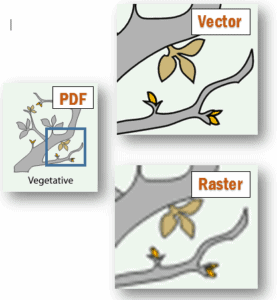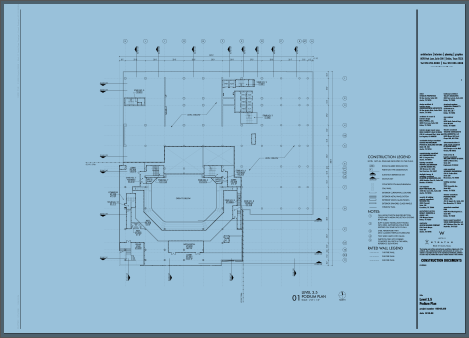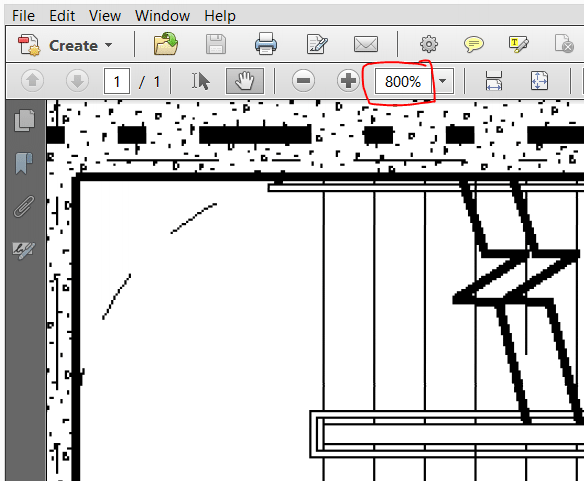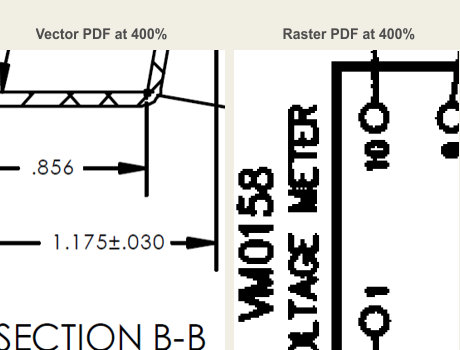What’s the Difference Between Raster and Vector PDF?

Knowing Which Type of PDF File You Have is Key. Easily distinguish between raster and vector PDF files in Adobe Acrobat. Vector PDF files are best processed through data extraction, ensuring accuracy and minimal manual clean-up. On the other hand, raster PDF files require tracing and operator involvement, along with manual clean-up. Visual Integrity specializes in tools for vector conversion, providing high-quality, accurate drawings from vector PDF input. If you have a raster PDF or scanned drawing, our software can transform it into a tracing layer for manual work-up.
Which PDF Conversion Tool Do I Need?
If you need to:
- Use PDF in a CAD/CAM program; look at pdf2cad, PDFin for AutoCAD, pdf2bricscad, PDF Import for DraftSight, PDFImport for ProgeCAD.
- Open and edit vector PDF diagrams in Visio; check out Insert PDF for Visio or pdf2picture
- Transform a PDF page into an editable PowerPoint slide; try Insert PDF in PowerPoint.
- Work with PDF-based graphics such as logos, drawings, diagrams, and charts; look at pdf2picture
- Convert PDF to image formats; try pdf2picture
- Convert a scanned drawing to an editable file, try the tracing tools in Adobe Illustrator, or search online for “raster-to-vector” solutions.
- Add PDF support to an application or automate a PDF conversion or creation process, check out our Developer Center
3 Ways to Tell The Difference Between Vector and Raster PDF
Watch a Short Video to Learn the Difference
Try the “Blue Test”
Visual Integrity specializes in tools for vector conversion and will produce high-quality, accurate drawings from vector PDF input. If a raster PDF or scanned drawing is run through our software, we will turn the flat image into a tracing layer for manual work-up. To determine if your PDF is a vector or raster, watch a short video explaining the difference or try the Blue Test. Open your PDF with Acrobat or Acrobat Reader and click anywhere on the drawing. If it turns blue, it’s a scanned drawing, and you may consider using a raster-to-vector tool, manual redraw, or outsourcing to a service bureau for redrawing.


The Zoom Test
Another way to tell the difference between vector and raster PDF is to open the file. Use Acrobat, Acrobat Reader or just your browser. Use the Magnifying Control to zoom in on a detailed section of the file. At 100-150%, it may be hard to tell the difference. Continue zooming until you are at a magnification greater than 400%.

The section of the picture should be magnified on your screen, and it quickly becomes apparent whether you have a vector or raster PDF file. The vector PDF file will look clear and smooth at any size, while the raster PDF will become blurry or grainier the more it’s zoomed.
Side-by-Side Comparison of Vector and Raster PDF
Visually evaluate the difference between vector and raster PDF. In the example below, the drawing is enlarged 400%. Sometimes, it’s necessary to magnify the file by more than 1000% if it’s a high-resolution scan to determine the file type. In this example, it’s possible to edit the vector PDF on the left but not the raster PDF on the right.

Which Graphics Formats Should I Pick For Web and Print?
Once you understand the two basic formats for graphics—vector and image—you know which tools to use. Vector graphics comprise objects, lines, curves, and text, while images comprise a collection of dots or pixels. Images are also referred to as bitmaps or rasters.
Visual Integrity can convert most PDF files into either vector or image formats. It’s important to know which is best for your job.
Vector Formats
If you need to edit a PDF file by breaking it down into objects and text, you should choose a vector format. Our software supports the vector formats DXF, PDF, PS, EPS, SVG, WMF, EMF, CGM, HPGL, and MIF.
Image Formats
Our software supports vector formats such as DXF, PDF, PS, EPS, SVG, WMF, EMF, CGM, HPGL, and MIF. If you require a sharp image for insertion into a document or web publication without editing, you can opt for image formats like TIFF, GIF, PNG, JPEG, and BMP. When printing on a printer, aim for a resolution of 150 or 300 dpi, while 96 or 72 dpi is suitable for screen display on websites. Higher dpi results in larger file sizes, so choose the lowest resolution that meets your quality requirements. It’s important to note that our software does not convert raster PDFs (scanned images) into editable objects; you’ll need raster-to-vector conversion software.
Note! Our software does not convert scanned images (raster PDFs) into editable objects. To convert scanned images into vector objects, you need a special class of software called “raster to vector.”
